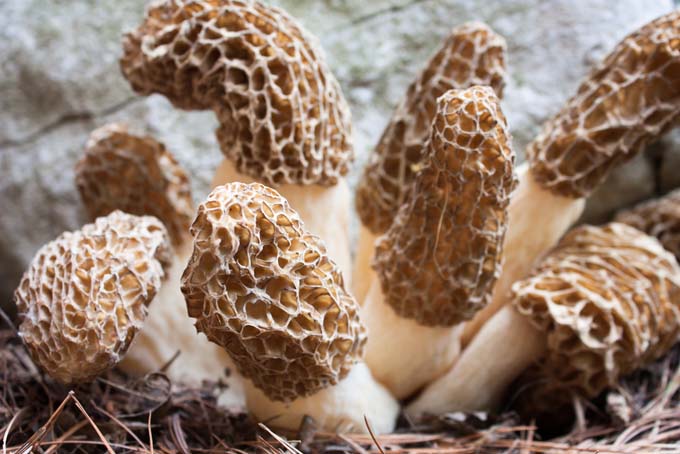Dehydrating morel mushrooms is a common practice among individuals who harvest a large amount during mushroom season (lucky you!)
The dehydration process is the number one method that allows you to savor the taste of these even during the off-season, as they do not freeze well (though it is possible).

Some say the best location to hunt for morels is in the Midwest, but you can find them all over the US, Europe, and beyond. This area seems to have the best vegetation and temperature to grow these tasty morsels. Look for them sprouting from mid-April to mid-June.
They usually appear after a series of spring showers, prior to the heat of summer setting in. Morels often reappear in the same spot year after year, and many hunters keep their “spots” a well guarded secret.
These fungi (yes – they are fungi) seem to prefer hillsides with plenty of rotting logs, but they may appear in unexpected spots as well. You may not find them where you’d expect – this is one reason why this variety isn’t commercially farmed.
Three basic processes exist for dehydrating morels. The first involves the use of a dehydrator. Here’s what you need to do:
1. First, wash the specimens in cool water to remove any debris.
2. Pat dry with a paper towel. Trim the stems if necessary.
3. Slice them in half, from the tip through the base of the stem.
4. Place in a single layer on each level of the dehydrator. Follow the manufacturer’s instructions for proper drying times, or check out our ultimate guide to food dehydration – it has a bunch of helpful drying times listed at the bottom.
For those individuals without a dehydrator, you can also use your oven to prepare the mushrooms.
1. Wash, dry, and cut the same way as previously outlined.
2. Cover the bottom of a cookie sheet with parchment paper. Lay out sliced mushrooms in a single layer. It is alright to have the sides touching, but they should not overlap.
3. Bake at 250°F for approximately 6 hours. During the baking process, crack open the oven door a slight amount. This allows the moisture to escape during the drying process.
Finally, the oldest known way to dry morels is to string them up and dry them in the sun.
1. Wash and prepare the individual pieces as before.
2. Cut a piece of cotton packaging string (kitchen string) that’s approximately six feet long. Thread a large-eyed needle, and insert through the center of a morel slice. Slide the mushroom along the cotton string until it’s within 12 inches of the opposite end.
3. Repeat the process with the remaining pieces, making sure they do not touch one another.
4. Hang the string in a sunny location. If you hang the string outside, be sure to bring it in at night to prevent dew from setting on it, which could introduce mold. Allow to dry in the sun for a minimum of two days.
The trick to drying morels is to make sure they are completely dry. Here’s how to test the mushrooms periodically during the drying process:
Break a small portion from the main body. It should snap when broken. If it is mushy or spongy, then moisture still exists within the cap.
Place the dehydrated specimens in a glass jar with a lid or in a resealable plastic bag. These will keep for up to six months if prepared correctly. You can further extend this by using vacuum sealing, placing them in the freezer after they’re dried (though this isn’t always recommended, as it can introduce moisture) or adding some oxygen absorbers to the sealed packaging.
Dehydrated morel mushrooms may be reconstituted by soaking them in enough cool, salted water to cover for 30 minutes, or by boiling them for 10 minutes at a low boil.
Be sure to reserve this water for cooking, as it is full of antioxidants. It makes a great addition to soups and sauces. Just let the sediment settle before adding the liquid on top to dishes.
And if you need a bit more info on the prep process, read our article on how to properly clean your mushrooms.
What’s your favorite way to dry the season’s bounty? Let us know in the comments!











































